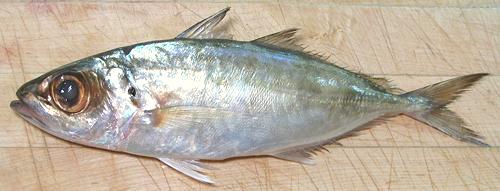 [Coulihou (Caribbean); Akula (Hawaii); Matan, Matangbaka (Philippine);
Ikan Selar (Malay); Purse-eyed Scad, Goggle-eyed Scad;
Selar crumenophthalmus | similar - Oxeye Scad;
Matangbaka (Philippine); Selar boops]
[Coulihou (Caribbean); Akula (Hawaii); Matan, Matangbaka (Philippine);
Ikan Selar (Malay); Purse-eyed Scad, Goggle-eyed Scad;
Selar crumenophthalmus | similar - Oxeye Scad;
Matangbaka (Philippine); Selar boops]
This is a "circumtropical" fish found all the way around the world above and below the equator, but its interpretation of the "tropical" part is a bit loose, since it's found as far north as Nova Scotia. It's a nocturnal fish traveling in schools of hundreds of thousands and can grow to 27 inches, but the photo specimen was 11 inches and weighed 9 ounces. This fish is kosher and is not threatened. A highly commercial fish, It is both fished wild and farmed.
Selar Boops, which has the same Philippine name, looks a lot like S. crumenophthalmus but is quite a bit smaller (to 11 inches) and is restricted to the Southeast Asian region.
More on the Scad.
This is a highly valued food fish in Asia and the Pacific, but in the Caribbean it is used more for bait to catch much larger fish. It is a medium flesh fish, not light but very much milder than most mackerel. The flesh is tender but it holds together well for all methods of cooking if it's not abused. There is a report of possible ciguatera poisoning in the Virgin Islands area.
Buying: This fish is common in Philippine markets here in Los Angles, but it is a fairly expensive for a scad. The photo specimen, from Hawaii, was purchased from a Philippine market in Eagle Rock for 2016 US $6.99 / pound.
Scales: There are very few scales on this fish and they scrape off easily without flying about.
Scutes: As with most scad there are hard scutes along the lateral line near the tail. They should be cut out before cooking.
Cleaning: When cleaning you might as well just remove and discard the head, as this fish is too strong tasting to make a good stock.
Yield: This is a fairly meaty fish so yield is decent with a 9.0 oz fish yielding 4.63 oz of fillet (51%). That's skin-on, but the skin is very thin and fragile so better to leave it on as with mackerel. A group of fish weighing between 9 and 6.38 ounces yielded 50%.
Skin: Frying a skin-on fillet, the skin shrinks noticeably but not enough to cause problems.
Filleting: This fish is easy to fillet.
Stock: This fish is considered to have too strong a taste to make a good soup stock.
sf_scadbez 060805 - www.clovegarden.com